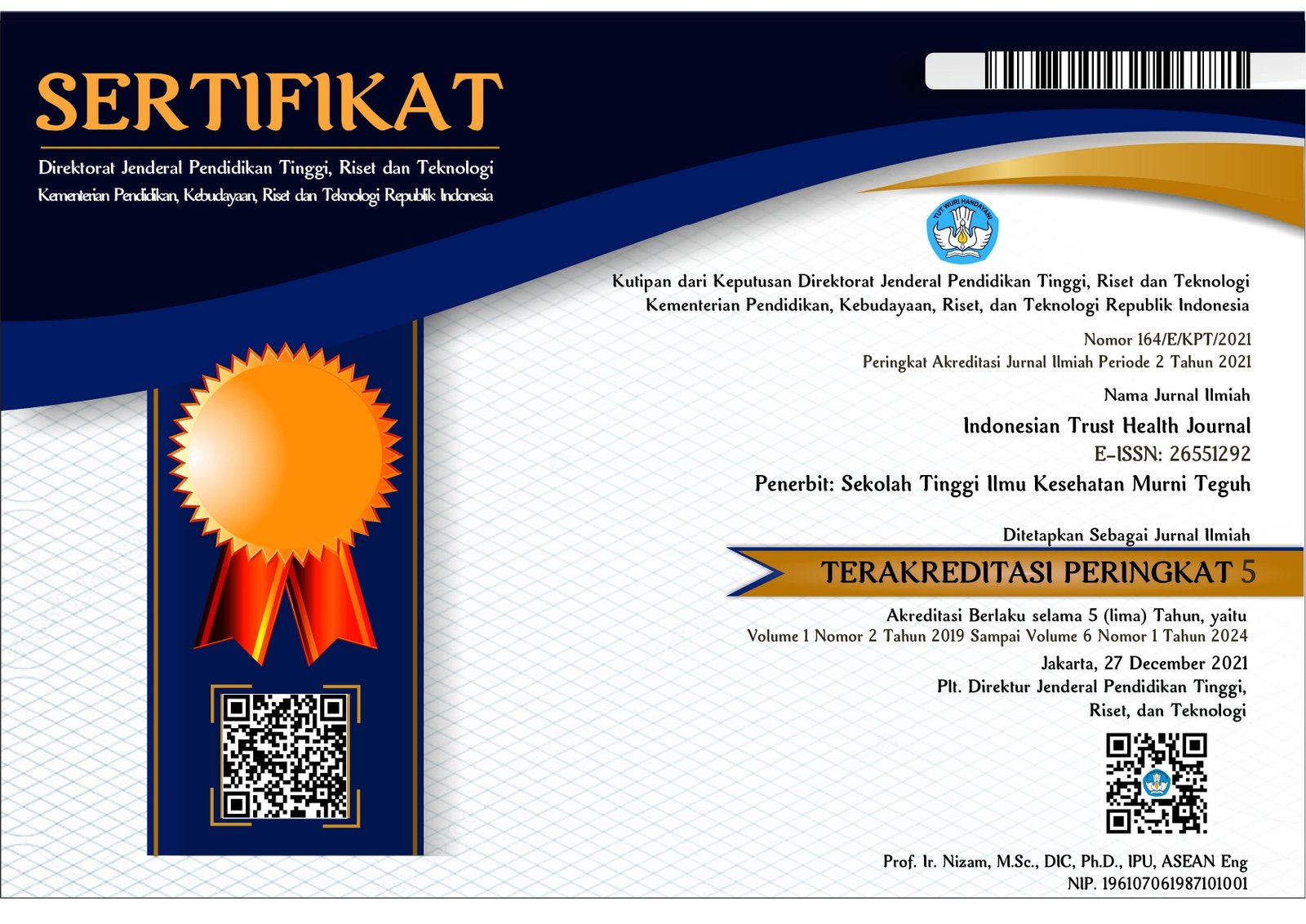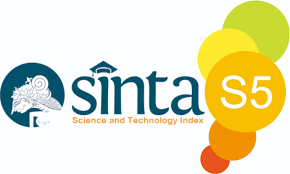PREVALENSI POST-TRAUMATIC STRESS DISORDER (PTSD) DI ANTARA PERAWAT PASCA TERKONFIRMASI COVID-19 DI PROVINSI SUMATERA UTARA
Abstract
Post-Traumatic Stress Disorder (PTSD) is a mental disorder that can occur as a result of direct or indirect contact with a traumatic event. The possibility of PTSD for nurses in the Covid-19 isolation room is the lack of staff which causes the nurse's working day to be longer, the lack of support and compensation from the organization. The current study aims to identify the prevalence of PTSD among post-confirmed Covid-19 nurses in North Sumatra Province. This study used a cross sectional study through a survey. This research was conducted from March to June 2022. The study population was all nurses who were confirmed to have Covid-19 in North Sumatra Province. The sampling technique is total sampling. The instrument was adopted from The PTSD Checklist for DSM-5 with Life Events Checklist for DSM-5 and Criterion A. This study used univariate statistical tests. The results of this study indicate that the distribution of the frequency of occurrence of PTSD with a Likert scale is not at all with a percentage of 47.1%, followed by a little bit with a frequency of 26.5%, while Extremely with a presentation of 5.4%. While the average value of the prevalence of PTSD in nurses after confirming Covid-19 in respondents as many as 509 nurses was not indicative of PTSD with an average value of 20.5. So, it was concluded that there was no indication of PTSD in nurses after confirmed Covid-19. It is recommended for future researchers to conduct qualitative research on PTSD experiences of nurses after confirmed Covid-19 and more specific research samples in special rooms that treat Covid-19 isolation patients.
Abstrak
Post-Traumatic Stress Disorder (PTSD) adalah gangguan mental yang dapat terjadi akibat kontak langsung atau tidak langsung dengan peristiwa traumatis. Kemungkinan terjadinya PTSD untuk perawat di ruang isolasi Covid-19 adalah kurangnya staf yang menyebabkan lama hari kerja perawat makin panjang, kurangnya dukungan dan kompensasi dari organisasi. Studi saat ini bertujuan untuk mengidentifikasi prevalensi PTSD di antara perawat pasca terkonfirmasi Covid-19 di Provinsi Sumatera Utara. Penelitian ini menggunakan studi Cross Sectional melalui survei. Penelitian ini dilakukan bulan Maret – Juni 2022. Populasi penelitian adalah seluruh perawat yang terkonfirmasi Covid-19 di Provinsi Sumatera Utara. Teknik Pengambilan sampel adalah total sampling. Instrumen diadopsi dari The PTSD Checklist for DSM-5 with Life Events Checklist for DSM-5 and Criterion A. Penelitian ini menggunakan uji statistik univariat. Hasil penelitian ini menunjukkan bahwa distribusi frekuensi terjadinya PTSD dengan skala likert adalah tidak sama sekali dengan presentase 47,1%, disusul oleh sedikit dengan frekuensi 26,5%, sementara sangat banyak dengan presentasi 5,4%. Sementara nilai rata-rata prevalensi terjadinya PTSD pada perawat pasca perkonfirmasi Covid-19 pada responden sebanyak 509 orang perawat adalah tidak terindikasi PTSD dengan nilai rata-rata 20,5. Maka disimpulkan bahwa tidak ada indikasi PTSD pada perawat pasca terkonfirmasi Covid-19. Direkomendasikan kepada peneliti selanjutnya agar melakukan penelitian secara kualitatif tentang pengalaman PTSD perawat pasca terkonfirmasi Covid-19 dan sampel penelitian lebih spesifik lagi di ruang khusus yang merawat pasien isolasi Covid-19.
References
2. United Nations (UN). (2020). The sustainable development goals report 2020. United States of America, New York: United Nations Publications.
3. Widodo, S., et al. (2020). Buku saku cegah covid-19. Surabaya, Indonesia: Pusat Informasi dan Humas Universitas Airlangga.
4. World Health Organization (WHO). (2020). Clinical management of covid-19. Diakses dari https://www.who.int/teams/ health-care-readiness/covid-19 pada tanggal 25 April 2023
5. Cucinotta, D., & Vanelli, M. (2020). WHO declares covid-19 a pandemic. Acta Biomedica, 91(1), 157–160. https://doi.org/10.23750/abm.v91i1.9397
6. Sugihantono, A., et al. (2020). Pedoman pencegahan dan penanganan coronavirus disease (COVID-19). Kementerian Kesehatan RI (Vol. 1). https://doi.org/10.33654/math.v4i0.299
7. Worldmeter. (2022). Reported cases and deaths by country or territory. Diakses dari https://www.who.int pada tanggal 5 pebruari 2022.
8. International Council of Nurses (ICN). (2021). International council of nurses covid-19 update covid-19. Diakses pada tanggal Maret 2022 dari https://www.icn.ch/sites/default/files/inlinefiles/ICN%20COVID19%20update%20report%20FINAL.pdf.
9. Dewan Pengurus Pusat Peratuan Perawat Nasional Indonesia (DPP PPNI). (2020). Panduan asuhan keperawatan di masa pandemi covid-19. (M. Adam, Ed.) (1st ed.). Jakarta, Indonesia: Dewan Pengurus Pusat Persatuan Perawat Nasional Indonesia (DPP PPNI). Retrieved from https://ppniinna.org
10. Dewan Pengurus Pusat Persatuan Perawat Nasional Indonesia (DPP PPNI). (2021). News issue on 2 January 2021. Diakses 18 January 2021 dari https://www.liputan6.com/health/read/4447485 /sebaran-504-tenaga-kesehatan-dan-medis-yang-meninggal-karena-virus-corona covid-19.
11. Chang, M.C., & Park, D. (2020). Incidence of post-traumatic stress disorder after coronavirus disease. Healthcare, 8(373), 1–7. doi.org/doi:10.3390/healthcare 8040373
12. Van Teijlingen, E., & Humphris, G. (2019). Psychology and sociology applied to medicine: an illustrated colour text, 4th edition. Edinburgh: Elsevier.
13. Bo, H. X., et al. (2021). Posttraumatic stress symptoms and attitude toward crisis mental health services among clinically stable patients with COVID-19 in China. Psychological medicine, 51(6), 1052-1053.
14. Rogers, J.P., et al. (2020). Psychiatric and neuropsychiatric presentations associated with severe coronavirus infections: a systematic review and meta-analysis with comparison to the COVID-19 pandemic. The Lancet Psychiatry, 7(7), 611–627. https://doi.org/10.1016/S2215-0366(20)30 203-0.
15. Forte, G., Favieri, F., Tambelli, R., & Casagrande, M. (2020). COVID-19 pandemic in the italian population: Validation of a post-traumatic stress disorder questionnaire and prevalence of PTSD symptomatology. International Journal of Environmental Research and Public Health, 17(4151), 1–14. https://doi.org/10.3390/ijerph17114151
16. Kucmin, T., Kucmin, A., Turska, D., Turski, A., & Nogalski, A. (2018). Coping styles and dispositional optimism as predictors of post-traumatic stress disorder (PTSD) symptoms intensity in paramedics Voivodeship Hospital for Neurotic and Psychiatric Patients in Suchowola. Psychiatr. Pol., 52(3), 557–571. https://doi.org/10.12740/PP/68514.
17. Tan, B.Y., et al. (2020). Psychological impact of the COVID-19 pandemic on health care workers in Singapore. Annals of internal medicine, 173(4), 317-320.
18. Wang, Y.X., Guo, H.T., Du, X.W., Song, W., Lu, C., & Hao, W.N. (2020). Factors associated with post-traumatic stress disorder of nurses exposed to corona virus disease 2019 in China. Medicine, 99(26), 1–6.https://doi.org/10.1097/MD. 0000000000020965.
19. Potter, P.A., Perry, A.G., Stockert, P., & Hall, A. (2016). Fundamental of nursing. 9th edition. edition revised. St. Louis, United States: Elsevier Mosby
20. Weathers, F.W., et al. (2013). The PTSD Checklist for DSM-5 with Life Events Checklist for DSM-5 and Criterion A. A Measurement Instrument; National Center for PTSD: Baltimore, MD, USA. Diakses dari https://www.ptsd.va.gov/ professional/assessment/te-measures/life _events_checklist.asp
Copyright (c) 2023 Indonesian Trust Health Journal

This work is licensed under a Creative Commons Attribution 4.0 International License.

















